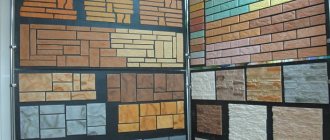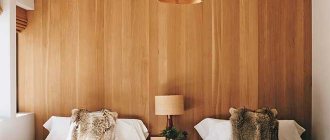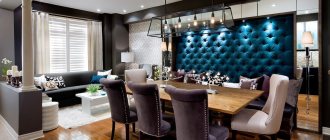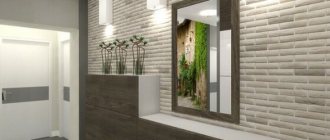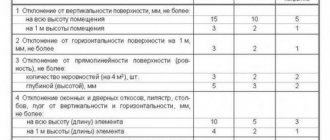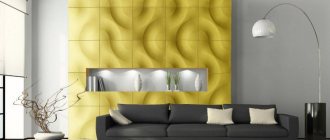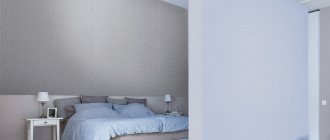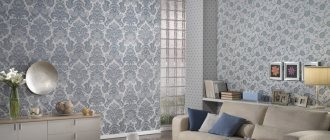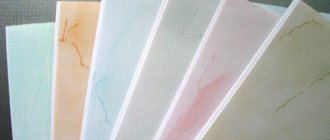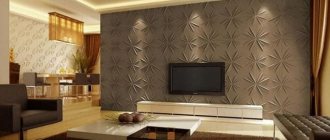Chipboard (chipboard) - chipboard, is widely known in construction. It should not be confused with the official abbreviation chipboard - wood-laminated plastic; it has a different structure and purpose. However, in the article, chipboard refers to wood-based particle material. Before choosing a product, it doesn’t hurt to get to know it better.
Wall lined with chipboard
Types of chipboard panels
There is a wide variety of materials on the construction market, classified by the number of layers:
- single-layer;
- three-layer;
- multilayer.
Existing grades P1, P2 are determined by the following indicators:
- bending strength;
- reaction to deformation;
- degree of water resistance;
- warping under the influence of water.
To determine the grade, pay attention to chips, cracks, individual stains, the quality of surface painting, protrusions, and depressions. For the first grade, defects are unacceptable and minimal. In the second, they are present in a small volume, with an average degree of deterioration. Slabs with serious defects are not assigned a grade; they are used in construction.
Unsanded chipboard
Based on the outer layer they are distinguished:
- unpolished;
- polished;
- coated.
Covered with veneer and thermosetting polymer film. Film-coated material is informally called chipboard. Although brands P1 and P2 have a certain degree of water resistance, they also produce moisture-resistant materials.
Interesting. Brand P2 resists moisture better than P1. After a day in water, the deformation of P2 is 22%, P1 – reaches 33%.
When antipyrines are added, the material becomes non-flammable. Classified by density and size.
Facade decor made of fiberboard and chipboard
Chipboard wall decoration
Lamination makes the chipboard surface resistant to moisture on the wall surface. When working with such panels, it is important not to forget to carefully insulate the ends and cut points with self-adhesive film or primer. When finishing the facade, moisture-resistant sheets are also used, followed by putty and painting.
Related article: Design of a private house
Hard material does not lend itself well to fine processing. When creating carved window frames, you have to use special cutters. Then the surface is sanded and, after deep impregnation with a primer, painted.
Ready-made platbands of a simple configuration are sold in stores with a laminated moisture-resistant coating for various types of wood.
High-hardness chipboard is used to create dacha walls, followed by varnishing. Sawdust materials are excellent for insulating wooden houses. At the same time, decorative elements of the facades are created and attached to the walls using glue and self-tapping screws. A lining that protects from direct contact with water and UV rays is required. You can make a wet facade and a ventilated one.
Pros and cons of chipboard
Advantages of particle boards:
- low price;
- strength;
- heat and sound insulation;
- variety of applications;
- ease of fastening;
- durability.
The cost is reduced, since the basis of production is wood waste. Pressed material is inferior in strength to wood or glued material; this reserve is enough for confident use in critical places, for covering. Chipboard is a fragile material, fasten it with nails and screws carefully.
The use of different coatings and finishes and low price make laminated chipboard more popular than MDF, although it is environmentally friendly and more flexible. The slabs are secured with nails, screws, and glue. If the material is used in suitable conditions, it lasts for decades.
The disadvantages include:
- presence of formaldehyde;
- insufficient water resistance;
- low strength;
- intractability during processing.
Due to moisture, many types warp, which limits their use, the panel collapses and becomes unusable. Inaccurate processing damages the slab, especially if it has been slightly damaged.
Types of finishing coating for chipboard wall panels
Panels are produced for covering walls with different coatings:
- covered with plywood;
- Laminated chipboard;
- Laminated chipboard;
- varnished.
This is what veneered chipboard looks like.
In the first case, veneer is used - a thin cut of wood. It is glued to the plate. It becomes like natural wood. This helps to imitate valuable species while spending less money. The main disadvantage is the price. To reduce the cost of repairs, different types of chipboard are used.
Laminated boards come in a variety of colors
Laminated with thermosetting films. They are applied to the prepared surface and sintered by hot pressing. The result is a smooth slab. The addition of dyes provides color variety. Expensive samples are coated with moisture-resistant varnish. It protects against mechanical damage.
One of the options for laminated chipboard
Cache with paper of the desired texture. Glue to the panel and coat with varnish. The paper wears out quickly, shortening its service life.
Carefully. Easily confused with chipboard, they are cheaper.
Buy a small sample, remove the top layer, and you will understand what type of coating it is. Or run your hand over the surface, plastic and paper give a different sensation, not everyone will feel the difference.
The varnished look can be immediately distinguished by its shine
Types of chipboard wall panels
When choosing a suitable solution for cladding the interior of a house or cottage, take into account that particle board has certain properties. In most cases, the use of wood material requires constant temperature and humidity in the room. Therefore, if it is necessary to carry out cladding in rooms with unstable conditions (hallways, some areas of the kitchen), it is better to give preference to chipboard with additional moisture-resistant impregnation.
Chipboard-based wall panels impress with their diversity
It is customary to distinguish the following types of products:
- Veneered. It is a panel coated with valuable wood veneer. This surface is obtained by gluing a thin section of wood onto a well-prepared base. The advantage of this option is that it is possible to obtain a cladding that completely matches the natural one. A significant disadvantage is the high cost, so the use of the material most often involves a combination with other types of cladding.
Slabs covered with natural veneer belong to the elite finishing class - Laminated. Laminated chipboard for wall decoration is the most popular. It is made by hot pressing; the facing coating is multilayer paper impregnated with special resins. This surface has good decorative potential and wear resistance.
Scheme of a moisture-resistant laminated chipboard panel - Laminated. It is one of the cheapest options and is often passed off as laminated chipboard, but is rarely found due to its low resistance to impacts. The technology for producing the material involves covering the panels with paper with the desired visual effect.
The laminated board is visually similar to its laminated counterpart, but the quality is worse - Lacquered. Such products are usually associated with old furniture, but in reality the potential of the products is much wider. The surface first receives the desired decorative effect (pasting with paper, laminating, painting), after which it is coated with varnish in several layers. The result is an interesting visual effect. The material can be repaired if scratches appear.
Modern varnished particle boards are distinguished by their unique quality
There are also types of products based on shape:
- Rack and grooved. Small thickness, fastened with an additional tongue-and-groove connection.
The tongue-and-groove connection greatly simplifies the installation process - Tiled. They have the shape of a square or rectangle.
- Leafy. Universal, used for various processes.
All wall panels must be supplied with certificates of compliance with environmental requirements.
Important! Such products are not suitable for finishing the outside of a house, even if they are moisture resistant.
How to choose chipboard panels
When choosing, pay attention to:
- coating;
- thickness;
- color;
- toxicity;
- density.
A coating for chipboard is necessary if it is a finishing cladding. It is better to take varnished, veneered, laminated boards. In other cases, cheap samples will do. Installation of thick slabs is not required; they are not subject to mechanical stress. Typically 9mm thick.
Quality is determined by the color of the slab (not the coating); the cut should be light. If it is dark, the panel has been burned, there is a lot of bark. The red color indicates putrefaction. Can be used for installation of the primary layer, not for cladding.
For interior work, it is necessary to take class E1 chipboard. You can find it out from the documentation. If this is not possible, use your sense of smell. Formaldehyde smells strongly if it is felt at a distance of more than 1 meter - a bad sign.
Advice. Chipboards produced in Austria and Germany are safer.
From time to time you need to attach something to the walls; this is done with screws or nails. If the material is of poor quality, the fasteners will weaken. Density is determined visually. The ends show the layering of the material: in the center of the chips, along the edges of the sawdust. The density is checked with a hard, blunt object or keys. If no dents remain when pressed, the density is sufficient.
Installation technology
The shape of the panels is:
- rack and pinion;
- tiled;
- leafy.
Slatted panels with glass inserts
The first type comes with a tongue-and-groove locking connection, which simplifies the joining of sheets. Tile - cut square or rectangular panels.
The most common leaf species
The chassis are sheet metal and are used for various purposes. Fastened in three ways:
- on glue;
- using components;
- using lathing.
On glue
This installation is used to preserve the appearance of the sheet in order to hide the fasteners. Before deciding on this method, make sure that the wall is strong and intact.
It should not have flaking, loose elements. Wooden, concrete, brick bases are suitable. Drywall is unacceptable; the paper with which it is covered may come off. Whitewashed and painted walls are not suitable.
Leveling the walls so that unevenness does not show through. Brick and concrete walls are primed, this will increase the adhesion between the chipboard and the wall, and coated with an antiseptic to prevent the appearance of fungus.
The back side of the panels is treated with sandpaper. Afterwards they are glued. The glue is selected according to the wall material. The main thing is that there is no water in the composition. Sheets can be glued together.
For special components
This method requires profiles. The design is collapsible. Once the profiles are installed, the sheets are installed quickly. The profiles become part of the wall, giving it design. Profiles are:
- corner;
- starting;
- end;
- connecting.
Diagram of a corner profile
Corners are divided into external, internal, and universal, when one profile is suitable for any option. They come decorated or unpainted. The profile is made of aluminum. Starter ones are used for vertical installation of panels. Mounted near the floor or ceiling. The end ones are designed to hide the outer sides and are U-shaped. The connecting joints are made in the shape of the letter H for joining sheets.
This is what the intermediate profile looks like
The profile is installed on the wall, if it is flat, on a metal or wooden frame. The wall is treated with an antiseptic.
On the sheathing
Another way to attach chipboard is to use lathing. It is convenient to work with wooden blocks, they are easy to process, and it is easy to attach panels to them. They have good heat and sound insulation properties and are environmentally friendly. Lathing is used, if insulation is necessary, to hide engineering structures and electrical wiring if the wall is uneven.
The bars are installed perpendicular to the slabs; if the sheets are placed horizontally, the sheathing is made with a vertical beam, and vice versa. Step 50 cm. Each block is leveled; it is necessary that their height is the same. This is done using a cord, a rail, a profile.
Chipboard is fastened with self-tapping screws, nails, screws, depending on the sheathing. The distance between the fastenings is 30–40 cm. Large sheets are more convenient to fasten to the profile. Walls become especially smooth when using sheets with tongue-and-groove locks. The video provides some installation tricks and calculations:
Types of chipboard panels
Decorative chipboard panels for walls come in three types:
- Rack, similar to lining (photo 1). Dimensions: length – 2.4-3.7 m, width – 12.5-30 cm, thickness – up to 12 mm. This coating can easily withstand the weight of shelves, hooks and hanging accessories. They are attached to the sheathing with nails and connected using the tongue-and-groove system.
Slatted panels - Wall panels “tiles” (photo 2). Dimensions: from 30*30 to 980*980. By combining planks of different sizes, colors and textures, you can realize absolutely any designer’s idea. They are attached directly to the wall or slatted frame using glue for various materials (Titanium, Master), liquid nails (Kimtek, Bison) or galvanized self-tapping screws. Wall panels “under tiles”
- Sheet panels for walls (photo 3) are large in size (1.22-2.44 with a thickness of 6-8 mm), and do not sag in the middle, like fiberboard or MDF. They are glued to a flat, dry wall, without oil stains or paint drips. Another method of fastening is a frame made of timber and self-tapping screws, while the hardware needs to be “recessed” into the panel by 1 mm, covered with decorative heel on top or puttied with tinted wood putty, sanded and varnished. The edges are covered with decorative corners, skirting boards, profiles, cornices, etc. Sheet chipboard panels
Such shields are often produced with a decorative surface like tiles, natural stone or brick, wood or textiles.
Very popular wall panels for kitchen work aprons are skinali (shown in the photo below). For these purposes, a finishing coating with a thickness of 6 to 12 mm made of moisture-resistant board is used.
This is what a kitchen decorated with skins looks like
However, you should take care in advance about holes for sockets or pipes. It is better to entrust the processing to professionals who cut furniture chipboard.
This solution is not suitable for baths and other wet rooms, since after some time the panels will still swell, begin to bend at the joints and warp.
Useful tips
When using screws, self-tapping screws, or nails, they are tightened and driven deep into the slabs. The holes are filled with PVA, painted over to match the desired color, or decorative plugs and nails with decorative heads are used. To make the fastenings look even, draw a line and mark the locations.
If the slabs are delivered in winter, they are kept in the room for a day before installation. When using finishing sheets, it is better to take from one batch, the shade will be the same.
Installation of chipboard is simple. If you follow these tips, you can avoid unwanted surprises. In conclusion, a brief overview of the material covered:
